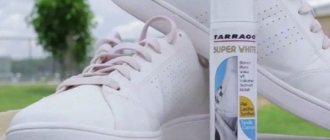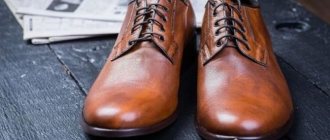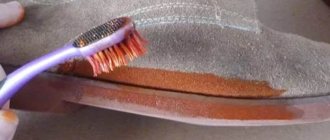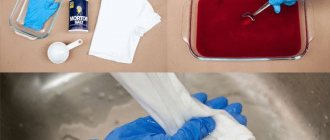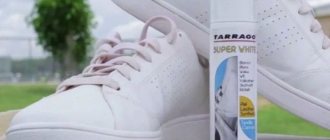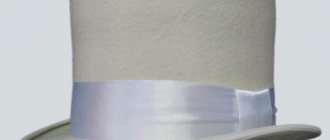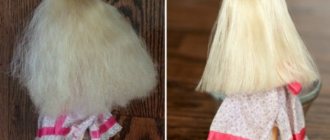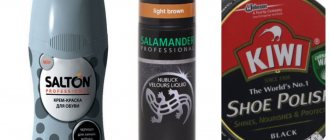You can restore shoes that have lost their attractiveness through painting. Returning the original color or changing to a new one will save money, especially if we are talking about an expensive pair. You need to start painting after careful preparation. Depending on the material from which the shoes are made, the methods of pre-processing will vary and special tools will be needed.
Handy products for painting eco-leather
Eco-leather differs from genuine leather in that its base is polyurethane.
The remaining components are natural. The material is used for the manufacture of furniture upholstery, accessories, clothing, and shoes. As with leather, natural dyes, aniline dyes, and silicone spray are used. Spray with silicone helps to distribute the paint evenly over the entire surface of the material. A protective film is formed, which gives the eco-leather additional resistance. The products are colored and colorless. They color eco-leather, serve as additional protection, add shine, and increase wear resistance. The dyeing process is the same as for natural leather.
Rubber
As a rule, the light, visible part of the sole of sneakers and the heels of women's shoes need painting. Alcohol-based shoe paint or an acrylic marker will help to update or restore the original color. In this case, it is better not to use the spray. Firstly, drips are possible, and secondly, the paint will not last long and will begin to peel off over time.
But you won’t be able to paint rubber shoes evenly and efficiently at home. The paint will begin to peel over time. In order to hide minor defects, you can use a waterproof marker or acrylic paint applied in several layers.
Ready-made paints
For leather products they produce “Extra” paint, nitro enamel, Enamel NTs-36, Viva Color Up. Rainbow ink is also used. Castor oil is added to any nitro paint. The first layer is primed with paint diluted in a solvent 1:3. The next two layers are painted with undiluted dye. Between stains, allow the material to dry for about 60 minutes, but not dry completely.
Well-known companies that produce high-quality paints and skin care products: Salamander, Silver, Cavallo, Platinum, Twist, Selton.
If you need an exotic color or pattern, you can use oil paints for painting. They are not applied in places where there are kinks, they will crack. The products take 3 days to dry.
To obtain a tint, use creams for leather items: Sochi, Karat, Polish and others. Natural suede is surface dyed with dissolved aniline dye. Purified and distilled water must be used. Use a stiff brush to pass over the suede surface.
Working with topcoat
Preparation
The surface must be cleaned from dust with a brush. Degrease with Cleaner LGR After this, apply paint, evenly distributing it over the surface. When working from a spray bottle, the can must be kept at the distance specified in the instructions. Otherwise, streaks may form instead of a uniform layer.
When using alcohol paints, it is better to work in a ventilated area, as intense evaporation occurs and may make you feel worse.
Application
The paint is applied with brushes, swabs with long handles or from spray bottles. If minor repairs to the product or drawing are being made, the remaining areas must be covered so as not to get dirty. This can be done with gauze, cloth, film, and secure the edges with masking tape. After use, tools must be washed in running water and soap. Allow to dry naturally.
Finishing
The product needs to dry for several hours and then undergo final polishing.
Cleaning
During wear, white leather is exposed to external influences. As a result, its surface may become dirty, scratched, peeled or cracked.
How to clean white skin?
The algorithm of actions is as follows:
- Apply a small amount of detergent and spread it onto the shoes from the outside and inside.
- Wash the leather surface with a brush or sponge.
- Rinse off any foam and remaining dirt under warm running water.
- Wipe the clean surface dry.
- Leave the product to dry away from direct sunlight and electrical appliances.
To prevent shoes from shrinking during the drying process, it is recommended to fill the inner surface with plain paper. It is better not to use newsprint for these purposes. Otherwise, the paint may print and cause the product to change color.
How to care for white shoes, besides washing shampoo? White leather shoes can be treated with a special conditioner. Its use helps soften the leather and prevent dry patches or cracks on shoes.
The conditioner is selected according to the color of the leather shoes. If there is damage on the surface, you should purchase a product several shades lighter than the skin color.
When treating shoes using this method, experts do not recommend using synthetic conditioner. It can ruin the quality of soft white leather.
Textile
Shoes made of fabric can also be dyed a different color.
Don't throw away sneakers that have served you for years. A pair of boring and ugly sneakers can be repainted into something truly impressive. Color and make patterns. You will have to make a lot of effort to make your favorite shoes please their owner again.
Preparation and tools
Fabric shoes are not afraid of water and soap solutions. Therefore, you can safely soak it in a bucket of dishwashing detergent and scrub it with a stiff brush.
Be careful with soaking. The adhesive composition may be damaged, and you will also have to take it in for repairs so that the sneakers do not get wet.
Dust also collects on fabric shoes and sneakers; it must be removed. If you apply paint to uncleaned materials, the appearance of the product will not become better than what you currently have.
You also need to bleach the sole. For these purposes, you can resort to traditional methods. For example, use ammonia, hydrogen peroxide, baking soda and salt, mustard, an old toothbrush and toothpaste.
You can remove dirt either manually or in a washing machine. Wash sneakers at a temperature of no more than 40 degrees. It is advisable to turn on the extra rinse and turn off the spin.
Sneakers should be dried naturally. Machine drying will damage the sole.
Paint such products with acrylic paint or purchase special paint at the store.
Variety of shoe cosmetics
“Budget” dyes and sprays that consumers often use are “Salamander”, “Salton” and “Farel”. Farel paint is effective for masking scuffs, dries quickly, but sometimes smells unpleasant. The Salamander product contains a pleasant fragrance, but it is not sprayed near the product and is not applied in a thick layer. A thick layer of the substance will cause streaks. The composition of the Salton dye returns the shoes to their original shine and newness. It is easy to apply and comes with a convenient applicator. They can be used to evenly distribute the dye over the entire surface.
There are dyes intended for professional use. They come in a variety of colors and are highly resistant to wear. Among them are paints from the French and Spanish manufacturer Tarrago. Composition form: creams, sprays, liquid skin. For daily coloring, you can buy an aerosol can. The substance must be applied at a distance of 15-20 cm from the product, and it is sprayed only in open air.
On a note!
Never save dye by touching up only individual spots and abrasions. This will ruin the appearance of the shoes.
For suede and nubuck, the dyes are Nubuk Suede Color from Tarrago and Nubuck Velor Fresh from. French paint "Sapphire Tenax" is used half an hour before leaving. Before use, shoes are cleaned and the suede pile is raised. Since this is a spray, it must be applied outdoors, and the distance between the surface of the shoe and the can should be from 15 to 20 cm.
Painting depending on the material
You can dye your shoes a different color at home, but you need to remember that this is a process that requires responsibility. The work is done slowly and in several passes. You need to apply layers as with regular painting, i.e. with a pause for drying. The treatment is carried out in two or three steps, distributing the coloring pigment evenly. The dyeing method is determined by the material.
Leather
How to dye leather shoes? First it needs to be primed to level out the abrasions. When it comes to painting white leather shoes, the priming step is important. An unprepared surface will lead to uneven distribution of pigment, and damaged areas will be noticeable in a different color. Defects are sealed using liquid leather.
Areas that do not require painting are sealed with tape , shoes or boots are stuffed with paper to maintain their shape.
are painted first . You can apply the coloring liquid or cream with pigment in a circular motion with a brush or sponge. When processing, you need to move the tool without pressure, i.e. the paint does not rub into the material.
It is not recommended to shake the composition, since the resulting air bubbles will negatively affect the evenness of the applied layer.
If an aerosol can is used, it is important to maintain a distance from the leather shoe (20 cm). When processing, it is necessary to go through sections at a time, i.e. It is important to avoid layering. Seams and bends are areas that require attention and increased accuracy. Once the paint is applied, the shoes are treated with a fixative, which is sometimes included in the paint kit. If there is no remedy, wipe the boots or shoes with a piece of dry rag soaked in a vinegar solution. You can wear the painted item after two days so that the applied composition dries properly.
Painting leather shoes
Textile
How can you paint a pair of shoes if they are made of fabric? The fabric covering wears out quickly. Sneakers or sandals with this finish lose color after washing, but you can return them to their original appearance using dye. Textile paints and acrylic-based products are applied carefully to avoid streaks. How to dye fabric shoes at home?
The procedure will be as follows:
- Shoes are washed and dried naturally. The laces are removed.
- The dye is diluted in a container in accordance with the instructions (the size of the container must be such that the steam is completely immersed in it).
- Plastic and rubber areas are treated with Vaseline.
- The pair is placed in a container and kept for up to 10 minutes.
- In another (prepared) container there is a solution of vinegar; the steam removed from the dye is placed in it.
- The product is washed until the water becomes clear.
- The shoes are dried naturally, the remaining Vaseline is removed.
Painting fabric shoes
Rubber
How to paint boots if they are made not of leather, but of rubber? The peculiarity of the material is that conventional compositions do not adhere well to it.
Please note: Basic criteria for choosing paint for children's wooden toys
You can update your boots using paint with an acrylic base or use enamel. The paint layer will not last long, but with careful use you can expect to wear throughout the season.
Painting is preceded by a preparation stage.
Boots should be thoroughly washed with soapy water, rinsed and dried. If you use an alcohol-based cleaner, the rubber will likely deteriorate. Soft solutions designed specifically for this material are suitable. You can prepare a stencil if you plan to apply a design to the boots. The drying time of the paint layer is determined by the chemical composition of the paint; it often takes a couple of days.
Painting rubber shoes
Suede and nubuck
How to paint shoes if they are made of suede or nubuck? The suede surface is cleaned with a stiff brush. You can clean the pores and degrease them with an alcohol solution. Another effective cleaning method involves steaming for a couple of minutes. The paint must be applied evenly.
The paint is applied in layers , and each layer must be given time to dry completely. To work, you will need a small brush to paint the seams. The lint on suede boots that have dried after painting will be lifted by the rubber side of the brush.
Shoes should also be treated with a solution that will repel water.
Nubuck is afraid of moisture, so cleaning should be as dry . Stubborn dirt is removed with an alcohol or soap solution. Only dry shoes need to be painted, and the only acceptable way to apply the composition is by spraying. The can of paint aerosol is kept at a distance of 20 cm from the shoe; during processing, try not to allow paint to build up.
Painting nubuck shoes
Selection of means
To repaint a leather jacket black or another color or restore an old one, a dye is needed. There is plenty to choose from. Knowing certain nuances will help you choose a product.
Is a dishwasher profitable?
Oh yes! No
Suitable for home coloring:
The dyeing process using any of them is completed with the use of a special fixative.
Which colors should you prefer?
Properties of important elements:
- Wax included. It gives leather products softness and shine. Smoothes out cracks and abrasions.
- Walnut oil. Makes the surface smooth. Some manufacturers use analogues in the form of petroleum jelly and glycerin instead.
- Jojoba or olive oils. They have a positive effect on the skin, nourishing and protecting it.
- Seal fat. Has water-repellent properties.
- Mink oil. Protects and gives the product a well-groomed appearance.
The French company Saphir produces leather dyes; they are very popular due to their positive reputation.
What you need for painting
To dye leather shoes at home and get excellent results, you will need:
- acetone or alcohol for preparing the product;
- gloves (disposable ones from the pharmacy will do);
- sandpaper or glass nail file to smooth out imperfections (deep scratches, abrasions) and remove heavy dirt;
- clean brush;
- protective water-repellent agents for treating shoes after painting or shoe cream (water-repellent spray, products containing silicone or beeswax);
- dye;
- liquid leather or primer for treating severely damaged areas;
- brushes of different sizes;
- masking tape or cling film.
It is also necessary to prepare the workplace: cover the surface with oilcloth or several layers of paper to protect the surface from dye.
Paint suede shoes
Suede shoes always look very impressive and rich. But nothing lasts forever, and over time it loses its color, it can fade and rub, or you just want to repaint your shoes a different color.
Suede shoes can be transformed by painting them with a special suede paint. To do this, you need to use the above mechanism, making sure in advance that the paint is intended for suede, and reading the instructions.
Don't forget to wear gloves to avoid damaging your skin.
Areas where the shoes have become shiny or worn out over time should be given special attention and brushed over with a small brush. And now your favorite suede boots have been transformed
Safety requirements
All shoe dyes contain harmful chemical compounds, so the procedure should be carried out on the street, balcony or near an open window. The same care must be taken when drying finished products. Using a protective mask will help reduce the amount of toxic fumes you inhale.
To prevent the dye from leaving traces, the workplace must be covered with oilcloth. Paper will not help in this case, as it easily absorbs liquid mixtures. To avoid getting your hands dirty and to avoid an allergic reaction, you need to wear rubber or plastic gloves when painting. During breaks between applying layers, the container with the product used must be tightly closed.
Previously, only experienced shoemakers knew how to repaint shoes or refresh their appearance. Today, you can update the color of your favorite pair of shoes at home at no extra cost. Retail outlets abound with high-quality products for carrying out this endeavor. If you take a responsible approach to choosing a coloring agent and carefully follow all stages of painting, you can get the desired result without much difficulty. Do not forget that well-groomed shoes increase self-esteem and contribute to the creation of an image.
Carry out painting outdoors or indoors with an open window. Use a protective mask. Protect the workplace from paint. Carry out painting with special gloves.
How to paint leather and leatherette shoes
Leather products and leatherette products are the easiest to paint, since the paint applies smoothly, easily and neatly to such a surface.
If necessary, you can paint the shoes completely or partially.
When partially painting, it is recommended to seal the outline using, for example, paper tape, this will help you get an even and clear line. Next we use the algorithm described above
Leather paint usually comes in a liquid or creamy form, so pour it from the bottle into a more convenient container, stir and apply to the leather surface, paying special attention to the joints and seams
Paint your shoes in one go, without distractions, to avoid streaks. To achieve maximum effect, you can repeat the process a couple of hours after the first staining.
After the paint has completely dried, apply care products to the shoes: cream, oil or wax.
Required tools and materials
Painting shoes will go smoothly if you prepare in advance. The -yourself includes:
- composition designed to remove grease and dirt;
- a piece of soft cloth;
- a sponge of medium hardness (if the product is suede, you will need a special brush);
- a sponge for sanding (it can be replaced with fine sandpaper or a nail file from a ladies' cosmetic bag);
- paint (selected based on the shoe material; the heel and sole will require a different composition);
- application tool (brush, sponge);
- paper tape, polyethylene for covering areas that do not require painting;
- pieces of paper (they are used for stuffing).
In order not to spoil your shoes, you need to approach the issue of choosing paint responsibly. It is better to prefer a brand with a reputation and positive reviews.
Shoe paint Essential tool for painting
How to paint rubber boots
Is it possible to paint rubber boots? Rubber shoes are designed for rainy seasons to resist moisture. It is problematic to repaint this material, but, nevertheless, it is still possible to create a creative individual design or eliminate some defects. To do this, you can use acrylic paint, enamel paint or another intended for rubber products; this can be checked with the seller.
Before painting, it is enough to wash the rubber boots with water and wipe them dry with a cloth; unlike leather boots, you should not wipe them with alcohol, as the rubber may deteriorate.
To apply a drawing or pattern, you can use a ready-made stencil or make it yourself.
After painting, it is better to leave rubber shoes to dry for several days.
Features of white skin coloring
White or colored products require especially careful handling. The cracks that form during wear are very noticeable and give the product an unkempt appearance. You can paint such shoes with liquid leather. It differs from the usual coloring composition in that after drying it forms a thin film that hides all cracks.
Liquid skin is applied with a manicure file or other thin metal object. The crack is closed in several steps. Each time, apply a thin layer of material and allow it to dry completely. You cannot immediately fill the defect by applying paint liberally. It will dry unevenly and fall off after the first walk. When the crack is repaired, the product is completely painted over in the usual way.
How to paint the heel of a shoe or the sole of a shoe
All women are familiar with the situation when a heel, stuck somewhere, becomes damaged or scratched after being removed. The soles of shoes are also often subject to scuffs. For modern technologies this is not a problem. You can completely repaint the shoes, or you can tint the heel and sole. The paint can be purchased at a specialized store, but it is also possible to use car paint in spray cans, due to the abundance of colors.
Clean and degrease the heel or sole. It is advisable to remove old paint using sandpaper and solvent if you want to paint worn dark shoes a rich black color, but if you have white shoes, this is not necessary.
Apply the paint in a thin layer, repeat if necessary. If the shoes are varnished, the heel can be varnished after painting.
The need to use shoe dyes
Paint for shoe leather is needed in the following cases:
- in case of mechanical damage;
- when the surface is abraded over time;
- with constant contact with reagents that are sprinkled on sidewalks.
If you want to wear your favorite shoes for two, three or more seasons, use shoe cosmetics. If defects, scratches and abrasions appear, they can always be eliminated. A good dye for boots will extend the life of your favorite pair, and you won’t have to buy new boots.
How to paint nubuck shoes
Natural fabrics and natural materials are considered the most comfortable, pleasant and beneficial for the body. One of the popular and elite types of genuine leather is nubuck. Nubuck shoes are very light, but nevertheless strong and durable. In order for high-quality shoes to serve you for a long time and justify their cost, you need to take good and careful care of them.
To paint nubuck shoes, you need to remember the most important thing: do not spray paint close to the object. This may make the color look unnatural. Cover the floor well, put on clothes that you don’t mind getting dirty, and spray paint from a distance of 20-30 cm.
Caring for dyed shoes
Painted shoes require care. When returning from the street, boots need to be cleaned of reagents (important in winter). To ensure that the product does not get wet and maintains a neat appearance, the surface is treated with special moisture-repellent compounds.
Pay attention to: Paint your sneakers yourself
The frequency and method of using anti- wet are indicated on the packaging, but many shoe sellers recommend doing the following. During the first treatment, apply the product 3 times with an interval of 20-30 minutes, from a distance of 30 cm, then wait until it dries completely. In subsequent times, a single spray is sufficient. In summer, nubuck shoes can be simply wiped clean from dust.
You can use a steam cleaner . It is not recommended to dry shoes on a radiator or with a hairdryer. To dry your boots, you can stuff the inside of them with newspaper, blot the surface with a cotton pad, and leave them to dry indoors. Dyed nubuck items should be stored in a fabric case.
Shoes must be cleaned after every trip outside.
Preliminary preparation
Before dyeing, sneakers need careful preparation. To do this, do the following:
- Wash your shoes thoroughly, removing dust and dirt from their surface. It is also worth getting rid of any remaining cream and wax.
- After the product has completely dried, the entire surface or individual fragments should be degreased. For this purpose, it is recommended to use special cleaners or use improvised materials - for example, a solution based on laundry soap and ammonia.
- Dry the sneakers thoroughly. It is recommended to do this naturally. It is strictly forbidden to dry shoes near radiators or other heating devices.
Genuine Leather
The accumulation of fat, dust and other contaminants on the surface of the shoe causes insufficient adhesion of the dye to the material. Before dyeing genuine leather sneakers, you should definitely prepare. The quality of staining depends on the thoroughness of the procedure. Thanks to proper preparation, you will be able to obtain a uniform and rich shade.
To do this, clean and degrease the surface. Then the product is polished and dried.
Faux leather
To prepare artificial leather for dyeing, you should perform the following steps:
- Cleansing. To begin with, the shoes should be treated with a soapy solution, and then rinsed with clean water. The procedure is performed with a cotton napkin or sponge.
- Degreasing. To carry out the manipulation, moisten the sponge in an alcohol solution and wipe the item. This will help remove any remaining dirt.
- Drying. Before painting, you should make sure that the leatherette is completely dry. It should dry naturally. Heating sources must not be used.
After cleaning, you must work with shoes only with gloves. Thanks to this, there will be no stains on the surface that will appear during painting.
How to prepare the product for use
Before dyeing, leather shoes must be cleaned of dust and dirt. Wash, wipe with a dry cloth and let dry. Products made of white or light leather must be degreased with alcohol before applying paint, otherwise it will not be possible to obtain an even color over the entire surface.
Severe abrasions and scratches are sanded using fine-grained sandpaper or a nail file. Then degrease with alcohol or a special product. To avoid contamination of the light-colored sole during work, it is necessary to seal it with masking tape. In the same way, you can protect decorative elements - buckles, locks, rhinestones.
Tip: Before you start dyeing, you can stuff your shoes or boots with paper. Small creases and folds will be smoothed out, and it will be easier to paint the surface evenly.
Preparatory stages
It’s better to paint your shoes well once than to waste time correcting mistakes due to hasty work.
It is necessary not only to select the right materials, but also to pay due attention to each stage of the process. Without thoroughly preparing shoes for painting, you should not expect an even tone and long-term results.
Shoes will acquire a uniform and rich color only if they first go through two stages: deep cleaning and polishing. The pores of the material must be open so that paint can easily penetrate into them. Its deep penetration will ensure lasting results.
Cleaning and degreasing
In order for the paint to have strong adhesion to the surface of the shoe, it is necessary to clean it thoroughly.
It is important to understand that removing street dust from boots is not enough, because underneath it there is a layer of cream or wax. Care products serve as an obstacle to the penetration of dye into the pores of the leather or other material of the shoe.
Products are cleaned using various means:
- Wet wipes. This option is suitable if you need to paint boots or shoes that have not been subjected to the application of greasy cream or wax. You need to treat the surface with a napkin several times.
- Soapy solution. Any solid or liquid cosmetic product will do; you can use dishwashing gel. If the first option is used, the block should be grated and dissolved in warm water. The disadvantage of this method is the need to thoroughly rinse the solution from the surface.
- Alcohol solution. The method is suitable even for textile shoes. This option involves the use of ethyl or ammonia. The ratio with water is 1:2. Vodka may be used.
- By professional means. They can come complete with paint or be sold separately. The use of a liquid substance is similar to the use of an alcohol solution. The cleaning foam should be applied to the surface of the shoes, wait 5 minutes and wipe off with a sponge along with the dirty residue.
A soap solution with the addition of ammonia cleans and degreases the surface well. Apply the composition using a piece of cloth or a napkin for wet cleaning. Places where dirt and shoe polish accumulate should be additionally treated with a medium-hard sponge. After all actions, you can move on to the next stage.
Wet wipes Soap solution
Alcohol solution Professional means
Sanding and drying
After degreasing, the shoes should be dried, then proceed to sanding using a special sponge or sandpaper. You can use a nail file. Sanding is necessary to smooth out small cracks and scratches, making them almost invisible. This step is not necessary before redying suede, nubuck or canvas shoes at home.
After sanding, the resulting dust from the surface of the boots must be thoroughly wiped off. Before you paint your shoes, you need to dry them thoroughly. On a wet surface, adhesion to the chemical composition will be much lower.
Dry
Rub over small cracks and scratches Wipe and dry thoroughly
Nuances of the dyeing process
When purchasing dye for leather shoes you will also need:
- soft napkin;
- brush;
- sponge;
- a little polyethylene and adhesive tape (if your shoes or boots have inserts).
Before staining, shoes must be completely washed (soles, surface, heels). A degreasing compound is applied to the top of the clean product, and the inserts are sealed with adhesive tape. Use a brush to treat greasy areas. Pre-cleaning shoes can be done with a simple composition. It's easy to make it yourself. To do this, 50 g of regular vodka is mixed with a glass of clean water. Add a tablespoon of any liquid product (soap or dishwashing liquid) to the solution. The resulting mixture is whipped until foamy and the shoes are treated with it.
First you need to carefully paint over all the abrasions and scratches. When working with leather, it is unacceptable to use compounds containing acetone. In addition to store-bought creams and sprays, you can also use folk remedies. If your boots are brown, treat them with coffee grounds. The thickener should be rubbed into the shoes with a soft sponge until a pleasant dark color appears. In extreme cases, the use of felt-tip pens is acceptable.
Distressed beauty
You need to be more than careful with such shoes, because any stains from food and drinks are difficult to remove. You should also try not to step into puddles and mud. Even traces of green grass will remain on white skin. And if we talk about public transport, where someone can step on their feet, then it seems that such shoes can only be worn by people who have a personal car. However, it is not. All these situations can be minimized if you know the rules for caring for white shoes.
Basic Rules
Previously, the phrase “white shoes” smacked of nothing but foppishness. However, now that the athletic-chic style has gained popularity, various sneakers, sneakers, slip-ons and sneakers have become an integral part of the wardrobe, displacing classic shoes. In addition, white contrasting soles are found even in casual models. For example, loafers, boat shoes or brogues.
By purchasing a pair of shoes that are white or simply have light-colored details or soles, a person seems to automatically enter the world of fashionistas. But this is only on one side. On the other hand, he has a need to closely monitor her condition.
Along with a new pair of light leather shoes, you also need to buy special products that are designed to care for them. This is because white skin undergoes additional processing during the bleaching process. It is thanks to it that the skin becomes softer and more elastic, but at the same time more susceptible to pollution. Here are some basic rules for caring for light-colored shoes:
- After purchasing a new pair of leather shoes, you should immediately wax them. This will prevent stains and excessive water permeability. If it is suede, then you need to purchase a special spray for it.
- It is recommended to store light leather products separately from dark and colored ones. This solution helps preserve their color. You can use either special shoe bags or original packaging.
- If minor dirt appears on your shoes, you should immediately get rid of it using a napkin or damp cloth. In the case of suede, you need to use a special brush.
Daily care
White leather shoes require regular care, which should be done after each wear. Otherwise, they will lose their presentable appearance and you can safely throw them in the trash. Constantly sending your favorite shoes in for repairs is also not the best idea, so you need to learn how to properly care for white leather shoes on a daily basis.
First, you should stock up on water-repellent spray and apply it to the leather product in the first days of wear. Cream will also work. They will prevent the appearance of stains from rain and dampness and will help keep the shoes in shape, because do not forget that leather is an elastic material.
After each wear, the product must be wiped with a soft, damp sponge that does not have any roughness that could scratch the skin. After complete drying, the shoes must be smeared with a special cream for white leather.
How to paint
To dye leather products at home, paint sprays or creams are used. Sprays are sprayed from a distance of 15-20 cm. Creamy or liquid compositions are applied with a sponge or brush in an even thin layer, carefully treating the seams. If necessary, you can spread the excess paint with a clean sponge.
If the damage is noticeable, especially on white leather, it is worth pre-coating the worn areas with a special primer. Deep scratches or cuts on leather shoes are treated with liquid leather - applied in a thin layer and left to dry. After this treatment, the color will be uniform over the entire surface.
Some paints are sold with a fixative that gives leather shoes a richer color and glossier shine. It is applied immediately after painting, after which the product must be allowed to dry for 24 hours. You should not use a hair dryer to speed up the drying process, since leather shoes may become deformed after heating.
Popular brands
When choosing shoe polish, you will find many products on sale from different manufacturers. It is worth getting to know each of them separately.
Collonil
The manufacturer specializes in the production of dyes, as well as brushes and dryers for boots. Paints available for sale include:
- sports shoes;
- smooth leather products;
- suede shoes.
The color palette includes the main colors: black, brown and neutral.
Erdal
Erdal products have several categories.
- Classic, includes creams in jars and tubes with a sponge applicator for application.
- Express, suitable for maintenance care. The composition includes beeswax, which provides excellent surface polishing.
- Protect performs the functions of high-quality protection and intensive care. Available in spray form.
KIWI
Kiwi products are presented in a range of creams and impregnations for leather shoes. The color palette is limited to black, brown and neutrals only.
SALAMANDER
One of the popular shoe cosmetics companies. From Salamander you can buy a variety of shoe care products, as well as paints for various materials. For nubuck, suede and velor, Professional Nubuck Velours Fresh aerosol is suitable, the color palette of which is presented in a rich assortment (more than 70 colors). For smooth skin, you can buy Leather Fresh spray, choosing the desired shade from a wide range of colors.
SALTON
Salton brand dye is available in a wide variety. You can buy spray or liquid paint with a sponge applicator. Moreover, the color palette is not limited to a few colors, but consists of more than 13 colors.
SAPHIR
The products from the French manufacturer have a rich color palette, which includes about 80 shades. You can choose a dye designed for dyeing smooth leather or suede. The range also includes products for eliminating minor defects on smooth skin, which should be used only on problem areas.
SILVER
Silver dyes are the most affordable. The range includes paints designed to restore the color of various materials. The palette contains only a few basic shades, however, the types of textures and packaging volumes are very diverse.
SITIL
Turkish brand products are presented in a small variety. To color smooth leather, you can purchase Sitil cream paint in black. The dye restores color well and protects shoes from salt and moisture.
TARRAGO
The Spanish brand has established itself as a reliable manufacturer of a huge variety of shoe care products. The brand has a professional line, which includes dyes for all types of natural and synthetic leather, as well as suede, nubuck and soles. The color range is presented in more than 75 shades.
TWIST
The brand's palette includes 14 shades. The paints are sold in liquid textures or aerosols and are intended for coloring smooth leather or suede.
DIVIDIC
A Russian company that specializes in the production of cosmetics for shoes. In the brand's range of paints you will find universal transparent products in the form of aerosols, suitable for both smooth leather and suede. The line also includes spray paints for smooth leather and aerosols for suede and nubuck, presented in black and brown shades.
For penetrating painting you will need:
Saphir Teinture
Saphir Decapant
Saphir Renovateur
Saphir Pommadier
Saphir Pate de Luxe
Dye brush
The author had high beige boots at his disposal. After several months, the color faded and in some places the skin showed a natural, crusty tint.
You can see how in places of abrasion (on the toe) the leather has acquired its natural color
Step 1: Removing Paint
First I used Saphir Decapant to remove the top coat of paint. There is a lot of advice on the Internet that acetone or gasoline can be used for this purpose, but according to experts, such treatment has an extremely detrimental effect on the skin. The advantage of Saphir Decapant solvent is the balance between the ability to remove dyes without negatively affecting the skin.
I wrapped a cotton napkin around my finger (put on rubber gloves first!) and soaked a small area with solvent. After this, I rubbed the product into the surface of the shoe in a circular motion, but over time, only a small part of the paint was able to come off. Then I remembered the advice of one of the forum members that you can use the back of the knife wrapped in cotton cloth. This really worked - you can scrape off the paint quickly this way!
Waxa Shop Comment: Saphir Decapant is effective at fading and removing some paint, but not all. We recommend using the finest sandpaper to effectively remove paint “to zero.”
Boots after paint removal I left the boots to dry for a day. The next step was painting
Step 2: Paint with penetrating dye
I ordered two packs of Saphir Teinture. One is dark blue 06 (left), the second is blue 23 (right)
My original plan was to mix 4 parts blue and 1 part dark blue for the base coat and 1 part blue and 1 part dark blue for the patina.
The instructions on the packaging were confusing: according to it, at least 100 ml of dye is required for high boots. Since I only have 100 ml at my disposal, there is not enough paint for patination.
After some thought, I decided to go the safe route and paint the shoes a single color, making a 1:1 mixture of each color.
Using a paint brush, I made a test stroke on the newspaper. As it turned out, Teinture dye has a very liquid consistency, just like water. Then I applied the first layer to the shoes, making sure that the strokes did not overlap and, as a result, did not create different shades of blue.
Evenly applying the first coat of penetrating shoe paint. Boot, painted in one coat and unpainted. The first coat is applied. As you can see, I protected some areas from accidental staining with paper tape. The final layer.
In total, 5 layers were applied and in the end I still had 25 ml left! I settled on coat 5 because I was happy with the color and further coats would have made the shade even darker. In hindsight, I should have followed the original plan and tried patination. 2-3 layers are more than enough, and therefore there would be more than enough paint.
Step 3: Backup Patination
After leaving the shoes to dry overnight, I showed the photos to my friend, who suggested trying a special patination method in which some parts of the shoe are treated with Saphir Decapant. As a result, these areas become lighter and look more polished. Justin from shoesnob describes this method as "reserve patination." How did I not think of this before!
The upper part of the boot is treated with Decapant to achieve a light patina.
Step 4: Creating the Finish
Having achieved a satisfactory result, I treat the shoes with Saphir Renovateur balm and leave for half a day.
After this, I continue according to the comprehensive shoe care process:
- Another layer of Renovateur revitalizing balm
- 2 layers of neutral Pommadier cream
- 1 layer of black Pommadier per sock
- Polishing the toe with Pate de Luxe wax Below are photos of the treated boots.
Conclusions and advice
- Mixing colors is very important. Plan in advance what shades you want and buy the right paint.
- Patination will require patience. Once you have removed the paint, you need to let the shoes sit for at least one day. Also, after painting, you should let the dye dry thoroughly, at least 1 day. The same applies to applying a restorative balm. During solvent treatment and subsequent painting, the leather will lose a significant amount of nutrients. She will need at least half a day to recover.
- Applying different layers allows you to achieve different shades. If possible, it is better to practice on crust flaps first.
Types of paints
A wide variety of paint types for eliminating defects on leather allows you to choose the best option that will improve the external condition of the damaged surface of a leather item. Special products can be used for painting the top, sides, and sole of the product. They can have a powder, liquid or creamy consistency and differ in properties, characteristics and methods of application.
Acrylic paints are water-based, with the addition of polyurethane and special additives, which have durable properties that are resistant to mechanical damage, infrared radiation and fading in the sun, and are not susceptible to high humidity. This type of paint has high performance properties and a durable protective coating.
Cream sneaker paint has a creamy consistency. It is packaged in tubes and applied to the surface of the product using a sponge. This type of paint has softening and water-repellent properties.
The most popular and easy to apply are sprays for painting shoes. They are widely used to improve the appearance of not only shoes, but also for furniture, car interiors, etc. Absorbs and dries quickly. It is well distributed over the entire surface and has excellent performance properties. Suitable for professional painting of leather, it is water-repellent and adheres well to the surface of the product. Improved results are guaranteed by several layers of application. Suitable for both natural and artificial leather, as well as suede and nubuck.
Aerosols, sprays and balms
In modern stores you can find many different products for dyeing suede. Such compositions differ in application method and quality. The greatest demand is for aerosols, spray bottles, liquid paints and restorative balms.
Dyes are able to penetrate deep into the structure of the fabric, providing it with uniform dyeing and long-lasting color. To use a spray bottle, you need to brush the skin and spray the product 20 cm. This method has such advantages as quick drying of the paint and ease of use.
When working with liquid compounds, you need to press the bottle with a sponge down onto the shoe and treat the surface. Whatever method is used, be sure to thoroughly clean the material before starting work.
There are now many effective coloring agents available; you just need to choose the right paint and apply it correctly. It is important not to make a mistake with the color shade, otherwise the result may be unpredictable. Suede leather cannot be dried on a radiator; it is better to get special dryers.
Heavy stains usually cannot be stained; even a special brush cannot always remove them, so it is better to carefully care for your shoes from the first days of purchase.
Varieties
Not all shoe paints are created equal. They differ depending on the purpose of use, color, composition, and seasonality of use. There are various types of substances on the market intended for coloring shoes:
- Acrylic. Suitable for smooth surfaces: leather, vinyl, nubuck. They are resistant to sunlight, mechanical damage, and moisture. Increases wear resistance. They have the ability to impart a matte finish. They feature a large selection of colors. Suitable for applying designs to leather.
- Based on beeswax and natural oils. Designed for varnished or very smooth surfaces, usually leather or substitute. Beeswax in the product performs an important function - it softens the skin and gives it shine and shine.
- Based on organic solvents. They are fatty and dense compositions that create a waterproof barrier in the form of a film that protects against frost, snow, and moisture. It is advisable to use for winter shoes.
- Containing turpentine. Used for shoes made of rough, thick materials.
Acrylic
Based on beeswax and natural oils With a waterproof barrier Containing turpentine
According to the form of release and the purpose of use of the paint, there are the following options:
Aerosols for suede. They penetrate deeply into the material, renew color, and retouch visible abrasions. With their help, you can easily spray paint over the entire surface of the shoe. Among the advantages - they dry quickly. Disadvantages: they often have a strong odor, the need to carry out treatment in the fresh air or with open windows, the effect is not very lasting. Emulsion compositions in liquid form. Prevents surfaces from cracking and stretching. Mainly used for repairing summer shoes. Stays on the surface for quite a long time. Cream. These are skin coloring products in the form of a thick paste. Applied with a sponge or tampon, they have a long-lasting effect. Not recommended for products made of suede, velor, nubuck. Sprays for leather products
When choosing, it is important that the shades completely match the color of the shoes. Sprays intended for textile shoes. Have a water-repellent effect
A great option for those who don’t know how to paint sneakers or sneakers. Express sponges. They have protective impregnation. Gives the surface color and shine. The disadvantages include a short-term effect.
You can purchase the dye in specialized shoe departments. Experts advise using only the product that matches the material of the boots and shoes. For example, leather cleaner will most likely ruin suede. Protection for white shoes deserves special attention. Since all damage is clearly visible on it, to eliminate it you should purchase cream paint with beeswax, which will not only restore the original color, but will also protect it from contamination in the future.
Aerosols for suede
Compositions in liquid formCream
Sprays for leather productsSprays for textile shoes
Express sponge with impregnation
Applying a protective coating
The protective coating after dyeing leather shoes performs several functions:
- fixative – additionally fixes the coloring matter on the surface (for example, after using a spray);
- protects against moisture and dust;
- adds shine and deep color.
As a protective coating, you can use water-repellent impregnations, wax or shoe polish. Suede products can be treated with a spray, and to fix the color, wipe the surface with water and vinegar.
Important: when processing suede, you need to lightly wipe it with a damp cloth, without letting it get wet.
Tips for care and storage
To ensure that suede shoes and boots do not lose their presentable appearance for a long time, they need to be properly cared for. The following tips will help you keep your shoes beautiful:
- It is not recommended to wear suede boots in wet weather because they will become rough after prolonged contact with water.
- A few hours before going out, a pair of shoes should be soaked in a water-repellent agent.
- Suede shoes should be stored in fabric bags that allow air to pass through well.
- Any abrasions should be immediately painted over.
- Before storing shoes for long-term storage, you need to clean them from dirt, treat them with a care product and comb them with a special brush.
With proper care, a pair of shoes will last a long time, and any scuffs can be eliminated with special dyes.
